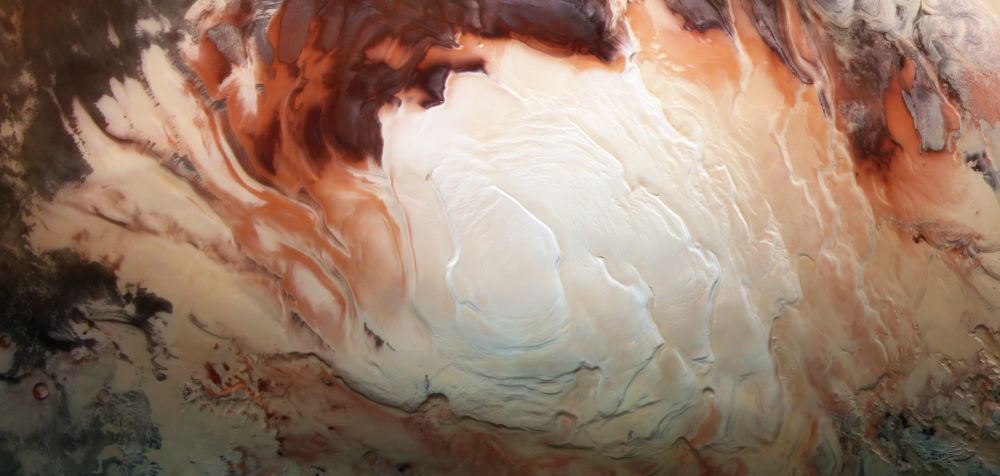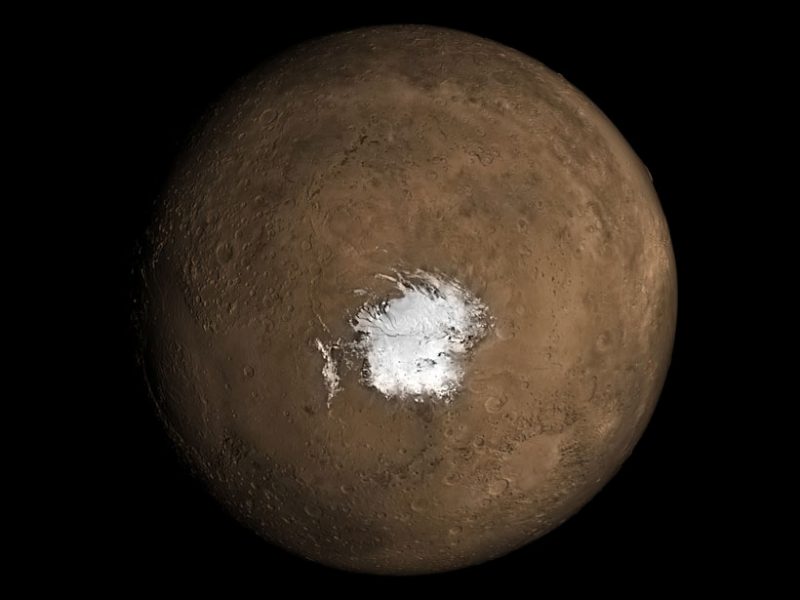Mars' Carbon Dioxide Glaciers are on the Move
By Matt Williams
In 1666, famed Italian astronomer and mathematician Giovanni Cassini (the man who discovered four of Saturn’s largest moons) observed the Martian polar ice caps for the first time. However, it was not until the late-18th century, when Sir William Herschel recorded his own observations, that the connection to Earth’s own ice caps was established. In his subsequent treatise, “On the remarkable appearances at the polar regions on the planet Mars” (1784), noted how the southern cap grew and shrunk due to seasonal changes.
With the development of modern telescopes and robotic explorers, scientists have learned a great deal more about these polar deposits. In 2011, they learned that unlike the northermost ice sheet, the southern cap is largely composed of frozen carbon dioxide (aka. “dry ice”). According to new research led by the Planetary Science Institute (PSI), glaciers of carbon dioxide ice have been moving and carving features in the southern polar region for more than 600,000 years – and are on the move right now!
The research team was led by Isaac Smith, a former PSI research scientist and an assistant professor of Earth and Space Science at York University in Toronto (where he also holds a Canada Research Chair in Planetary Science). He was joined by geologists, glaciologists, and engineers from the PSI, York University, the Institute of Low-Temperature Science and Arctic Research Center at Hokkaido University in Japan, and the NASA Jet Propulsion Laboratory (JPL).

The presence of carbon dioxide glaciers in Mars’ southern polar region was first confirmed in 2011 by the Mars Reconnaissance Orbiter (MRO). Along with data obtained by the ESA’s Mars Express, scientists noted that they were flowing like glaciers of water ice do here on Earth, based on the surface features they carved in their wake. As Smith described in a recent PSI press release:
“Approximately 600,000 years ago, CO2 ice started forming at the Martian south pole. Due to climate cycles, the ice has increased in volume and mass several times, interrupted by periods of mass loss through sublimation. If the ice had never flowed, then it would mostly be where it was originally deposited, and the thickest ice would only be about 45 meters thick. Instead, because it flowed downhill into basins and spiral troughs – curvilinear basins – where it ponded, it was able to form deposits reaching one kilometer thick.”
These observations also showed that the portion of the ice cap composed of water ice appears to be stationary, remaining at high altitudes. In previous research, which Smith helped contribute to while still with the PSI, scientists investigated the strength properties (aka. flow laws) of the carbon dioxide glaciers to determine why this was happening. Their results indicated that under the types of conditions that exist around the southern polar region, carbon dioxide ice flows were almost 100 times faster than water ice glaciers.
For this, they concluded that the CO2 ice behaves like glaciers here on Earth, which makes the slow-moving water ice cap appear stationary. “The glaciers have enough mass that if sublimated, they would double the atmospheric pressure of the planet,” Smith added, citing a 2018 paper by Than Putzig, a PSI Senior Scientist and co-author on this paper. “The longest glacier is about 200 kilometers long and about 40 kilometers across. These are big!”

For this study, Smith and his colleagues relied on the NASA Ice Sheet and Sea-Level System Model (ISSM) to model the glacier’s movements. When adapted for conditions on the surface of Mars and with CO2, they found that typical methods were not moving the carbon dioxide glaciers. They found that while the activity is ongoing, the flow rates peaked about 400,000 years ago when the deposition was at its greatest. Since their ice is currently decreasing in mass, said Smith, the flow rate of the glaciers is currently in a “slow period”:
“Atmospheric deposition would put the ice in a pattern we don’t see. It would be much more evenly spread and thinner. What the glacier interpretation provides is a mechanism to move the ice from high places, into the lower basins that are also at lower [latitudes].
“If atmospheric deposition were the only process acting on the ice, then most of it would be found at the highest latitude and highest elevation. That’s just not the case. The ice is flowing downhill into basins, much like water flows downhill into lakes. Only glacial flow can explain the distribution we found in 2018.”
This work is bolstered by additional research performed by Smith and his team, which identified several surface features that are very good analogs for features seen on terrestrial glaciers. These include topographic profiles, crevasses, and compression ridges, which provided a basis to compare with their adapted-ISSM models. These findings could also inform future planetary surveys and point towards more “Earth-like” glacier activity.

To date, Earth, Mars, and Pluto are the only bodies in the Solar System known to have actively flowing ice, ranging from water ice and CO2 to frozen nitrogen. But there are many other icy bodies in the Solar System, including the larger satellites that orbit Jupiter, Saturn, Uranus, and Neptune, and the growing number of smaller planets discovered in the Kuiper Belt. Many of these same bodies experience regular exchanges between their interiors and surfaces (endogenic resurfacing, cryovolcanism, etc.).
Many of these bodies will likely have glaciers of their own composed of substances like carbon monoxide, ammonia, and methane, which could behave in even more exotic ways! In the coming years, scientists will be able to test these theories thanks to missions like the Europa Clipper and the Enceladus Orbiter, which will explore two major satellites that have interior oceans and may even support life. The dynamics of their icy surfaces could provide additional evidence of how these moons formed and evolved.
The paper that describes their findings recently appeared in the journal JGR Planets, a publication overseen by the American Geological Union (AGU).
Further Reading: PSI
The post Mars' Carbon Dioxide Glaciers are on the Move appeared first on Universe Today.

May 11, 2022 at 02:45AM
via Universe Today read more...

Post a Comment